|
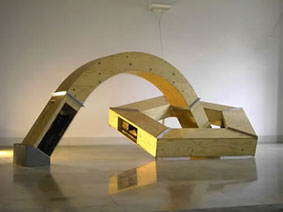
Material Flow
1989/1990
(15) about "Material Flow"
The partially open, partially closed tunnel or
shaft system of the structure, which is made of plywood, concrete, bronzed
plaster and aluminum, has been executed as a set of geometric forms.
On the one hand, the installation, which calls to mind the work of Auguste
Rodin and Medardo Rosso, is an emblematic – that is, abridged – representation
of a traffic network through which the sculpted cars and trucks are moving.
On the other hand, it can be seen more generally as a three-dimensional
transposition and metaphor for the principle of information transmission
from a sender to a receiver via a transmission channel. Here, though,
the term “metaphor” – the transfer of imagery – is
redundant, since from an etymological standpoint the Greek meta-phérein
already means “to carry elsewhere” or “to transport”.
Outsiders who are only taking part peripherally in this transmission
of information have at best a fragmented understanding of the transmitted
information, the transmitted material and the transmission routes. They
are either excluded from the abridged representation of the system (which
could also be a logistics network) or only touch a single point.
Wenzel Mraček:
W.W. Angers Mind
Using Literature to follow the Artist´s Train of Thought
Page 104/105
(16) about "Egocentric Universe"
Proceeding
from the idea that the configurations of stars described as heavenly
constellations only exist from our viewpoint on earth, the artist conceived
and portrayed a system of relations to close and distant relatives, friends
and acquaintances. Their portraits, made in the style of silhouette paper
cuts, are linked by a system of metal bars modeled on the lines of star
constellations, and a bust of W. W. Anger lying in a central position
on the floor marks out the critical point of view.
Wenzel Mraček:
W.W. Angers Mind
Using Literature to follow the Artist´s Train of Thought
Page 108
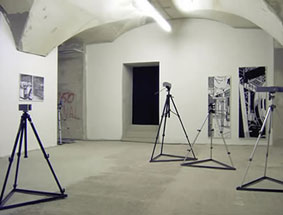
Time Spaces
1990/1991
(17) about "Time Spaces"
The photographic material that formed the
basis of his work originated before W.W. Anger or a viewer of his age
could possibly have had any real-life experience of the motifs. Nevertheless,
the pictures of places and situations, conveyed exclusively through the
media, have made their way into Austrian memory. In keeping with the
previous explanations presented here, they may be described as construction
elements of both history and reality. To help viewers understand these
reproduced images, W. W. Anger built “simple” optical instruments
that on the one hand performed a synthesizing function, merging several
images into one, and on the other enabled each viewer to see images that
no other person could see at the same time. By means of these instruments,
W. W. Anger controlled what the viewer saw, restricting the possible
perceptions of objects that themselves could no longer lay claim to communicating
reality since they had been manipulated through the artistic intervention
of reproduction. Naturally, this intervention must be interpreted in
an artistic context and not from a historical, documentary perspective,
but there are obvious links to the difficulties of both writing history
and canonizing historical reality (or -realities): who determines what
facts continue to go down in the annals of history, and who links these
facts through narratio?
Wenzel
Mraček: W.W. Angers Mind
Using Literature to follow the Artist´s Train of Thought
Page 114
(18) about "The Thing?"
“Heidegger discusses the presence of
things, but for my part I believe that we live in a world of commodities.
They are interchangeable, and things disappear behind commodities.”
W.W. Anger, out of the correspondence with
Johann Becker
Page 116
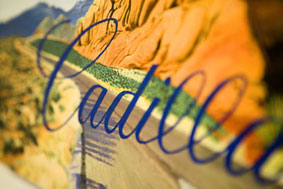
Import – Export – Leisure
1998
(19) about "Import - Export -
Leisure"
The promise of freedom suggested by the stereotypical landscapes (which,
in keeping with Jean Baudrillard, we could also view as simulacra, as referenceless
images that only stand for a secondary claim to reality, one all their
own, rather than for a particular historical reality) is disrupted by the
relationship to a brand: it is only when we buy a product of this brand
that we can experience freedom. Yet the landscapes, as desiderata for freedom,
have also produced the homogeneity of space since the expansion of the
traffic network has run parallel to the development of the automobile,
not only bringing the city ever closer to the country, but also making
the street into a substitute for the country. Traveling has become a means
of timeless conveyance from place to place, an overcoming of intermediary
space.
Wenzel Mraček: W.W. Angers Mind
Using Literature to follow the Artist´s Train of Thought
Page 117/118
(20) about " Roped Party or We Do Not Communicate
with Ourselfs"
Bourdieu, a sort of philosophical field researcher,
introduces the word “habitus” to
describe three sets of attitudes: the middle class sets store by education
and achievement, the upper class regards rank and refinement as its distinguishing
principles, and the lower class is characterized by a “taste of
necessity”. Socially mobile individuals who are seeking out the
next highest habitus are compelled to enter into alliances. Specific
elite groups play a dominant role in particular areas of society, but
they pass power down to their own kind. These elite groups possess one
or several forms of capital – cultural, economic, and/or social.
The economic value of relationships are revealed in such questions as:
Who do you know? Who can be beneficial? Who can transform social capital
into economic capital?
Wenzel
Mraček: W.W. Angers Mind
Using Literature to follow the Artist´s Train of Thought
Page 119
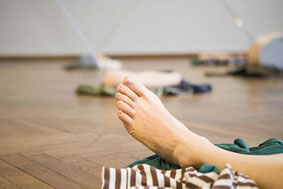
Factual Bodies
2003
(21) about "Factual Bodies"
The reproduced parts of W. W. Anger’s body do not seem to belong
together, and the antennae only hypothetically allude to the possibility
of the entire body being put together from the individual pieces. As
in The Doll by Hans Bellmer, there is a risk of anagramming the body,
but this is avoided here through a systemizing approach. This work also
recalls Ernst Mach’s description of the multiple ego, his theory
that the personality can never be grasped as absolute – and, beyond
this, that it can be randomly manipulated and adapted to all possible
requirements. Just as these body parts, controlled externally, can be
pieced together, so too will the mind become obsolete as a center of
control and cognition (which is still the case in Egozentrisches Universum).
What is required, according to Mach, is “a characterless, faceless
individual who assembles himself into a new person in response to diverse
ideological options”. And, lo and behold, in W. W. Anger’s
Tatsachenkörper we look in vain for the artist’s head.
Wenzel
Mraček: W.W. Angers Mind
Using Literature to follow the Artist´s Train of Thought
Page 121
(22) about "Egocentric Universe"
If I were to chart my entire private universe as precisely as possible,
a self-portrait would be inevitable. This self-portrait would consist
of the blind spot designating the standpoint from which the universe
is seen. In other words, it would be a negative description. ... The
invisible and unknown thing left behind would be the ego. The ego consists
of and can be defined by nothing but its surroundings. A NEGATIVE.
W.W. Anger 1991-06-03
Page 131
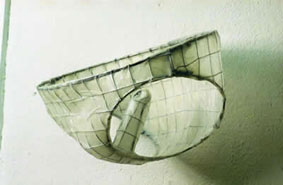
Fuck you - Fuck me
1993
(23) about "Fuck you - Fuck me"
It is supposed to be reminiscent of hulls or empty cocoons. At the same
time, though, it is impossible to miss the sexual nature of the entire
work. What especially interests me about this subject is the practice
of covering and concealing so as to arouse interest in what is concealed.
However, as things progress this original impulse disappears and the
covering itself becomes an object of desire, a fetish. The original objects
of desire vanish and what remains are empty shells or fetishes.
W.W. Anger,
1993-04-20
Page 141
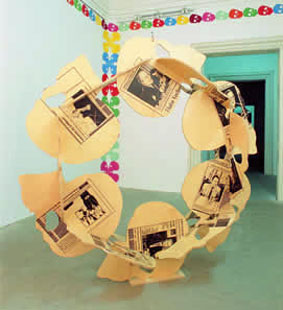
Still/Life
1994
(24) about "Still/Life"
The initial impulse for this work was the feeling that the expanding
capitalist, neoliberal economic system makes not only promises of happiness,
but also a death threat: the threat of power, the threat of expulsion.
W.W. Anger,
2003-12-29
Page 143
(25) über "Headquarter"
I would like to see this work in the tradition of vedutes such as those
painted by Canaletto. At the same time I want to emphasize the anachronistic
aspect of this venture ... Of course I am aware of the naivety of this
undertaking. This is exactly what makes artistic naivety a component of
the entire project. Indeed, it is a question of wanting to depict something
that cannot be depicted as such. And it is exactly this lack of success
that makes it possible to experience something about the object originally
chosen for depiction.
W.W. Anger, 2003-04-07
Page 165
(26) about "Import - Export -Leisure"
If
the landscapes are nothing but illustrations of empty grids and hence
messages from unknown places, then the rows of cars are the channels
in the related information system. The empty spaces of the unknown ...
as empty as a thing can be, are ideal vehicles for images – containers
that exist only to collect promises of freedom. ... Though the photos
also refer to the construction of landscapes and metropolises using different
media.
From: Bill Grawen, “Kein Frühstück
im Grünen” (Not
a Luncheon on the Grass)
Page 167
All citations out of:
Werner Fenz (publisher):
W.W. Anger.subSYSTEME.Das Werkbuch
|
|
(15) über "Materialfluss"
Die aus Sperrholz, Beton, bronziertem Gips
und Aluminium bestehende Konstruktion steht mit ihren in geometrischen
Formen ausgebildeten, teils geöffneten, teils geschlossenen Schacht- oder Tunnelsystemen einerseits
zeichenhaft, also verkürzt, für ein Verkehrswegenetz, durch
welches sich offenbar als Plastiken – erinnernd an die Manier Auguste
Rodins oder Medardo Rossos – dargestellte Personen- und Lastautos
bewegen. Andererseits aber, und allgemeiner, steht die Installation für
eine plastische Transposition und Metapher des Prinzips der Informationsübertragung
von einem Sender zu einem Empfänger über eine Übertragungsstrecke,
wobei hier die Bezeichnung Metapher, die bildhafte Übertragung,
in Bezug auf Materialfluss selbst schon ein redundantes Moment enthält,
nachdem etymologisch das griechische meta-phérein für anderswohin
tragen oder übertragen steht. Für einen Außenstehenden,
an dieser Informationsübertragung nur peripher Beteiligten, bleiben
die übermittelte Information, das übermittelte Material wie
die Kenntnis der Übertragungswege bestenfalls fragmentarisch erfassbar.
Dieser Dritte wäre aus dem verkürzt dargestellten System, das
auch ein logistisches sein könnte, entweder ausgeschlossen oder
er tangierte ein System, wie es Materialfluss darstellt, eben nur.
Wenzel Mraček:
Der Kopf des W.W. Anger
Versuch, mittels Literatur mit dem Künstler zu denken
Seite 104/105
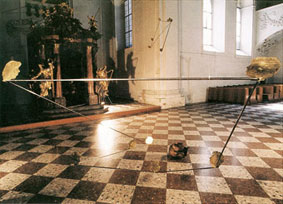
Egozentrisches Universum
1990/1992
(16) über "Egozentrisches Universum"
Ausgehend von der Überlegung, die von uns
als Sternbilder bezeichneten Konstellationen existierten alleine durch
unseren Blickpunkt von der Erde aus, konstruierte er ein Beziehungssystem
zwischen – auch in der Arbeit so dargestellten – näheren
und ferneren Verwandten, Freunden und Bekannten. In der Manier von Scherenschnitten
im Profil sind deren Porträts durch ein Sternbildern nachempfundenes
System von Metallstangen miteinander verbunden, den kritischen Blickpunkt
bezeichnet eine zentral auf dem Boden darunter liegende Porträtbüste
W. W. Angers.
Wenzel Mraček:
Der Kopf des W.W. Anger
Versuch, mittels Literatur mit dem Künstler zu denken
Seite 108
(17) über "Zeiträume"
Das fotografische Ausgangsmaterial stammt
aus einer Zeit, in der weder W. W. Anger noch Betrachter vergleichbaren
Alters reale Erfahrungen mit den Motiven verbinden konnten. Gleichwohl
gingen die Bilder von Orten und Situationen, nicht anders als medial
vermittelt, in ein österreichisches
Gedächtnis ein, und man darf sie im Sinn der bisherigen Ausführungen
wohl als Elemente einer Geschichts- und Wirklichkeitskonstruktion bezeichnen.
Zur Erfassung dieser reproduzierten Bilder durch eine Betrachterin, einen
Betrachter, und als Teil der Installation konstruierte W. W. Anger „einfache“ optische
Geräte, die einerseits einen synthetischen Effekt bewirkten, der
mehrere Bilder scheinbar zu einem verschmelzen ließ, andererseits
sah ein Betrachter nun Bilder, wie gleichzeitig kein anderer sie sehen
konnte. W. W. Anger dirigierte damit aber auch den Blick des Betrachters
und begrenzte ein Spektrum möglicher Wahrnehmung von Objekten, denen
selbst schon kein Anspruch mehr attestiert werden konnte, Wirklichkeit
zu vermitteln, nachdem auch sie durch den künstlerischen Eingriff,
die Reproduktion, manipuliert worden waren. Freilich ist diese Intervention
aus dem Kunstkontext zu interpretieren und nicht aus einem historisch-dokumentarischen.
Bezüge allerdings zu Problemen der Geschichtsschreibung oder Kanonisierung
historischer Wirklichkeit(en) sind offensichtlich: Wer bestimmt, was
weiterhin als historisches Faktum in einen Kanon eingeht, und wer verbindet
die Fakten durch Narratio?
Wenzel Mraček:
Der Kopf des W.W. Anger
Versuch, mittels Literatur mit dem Künstler zu denken
Seite 114
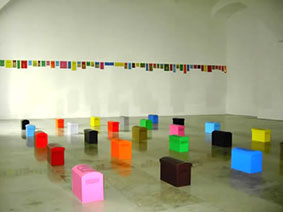
Das Ding?
1992
(18) über "Das
Ding?"
„Heidegger spricht von der Präsenz der Dinge, obwohl ich
meine, dass wir in einer Welt der Waren leben. Sie sind austauschbar, und
hinter der Ware verschwinden die Dinge“
W.W. Anger,
im Briefwechsel mit Johann Becker
Seite 116
(19) über "Import
- Export - Freizeit"
Das durch Stereotypen von Landschaft
(im Sinn von Jean Baudrillard könnten diese Landschaften auch
Simulakren sein, referenzlose Bilder, die für keine historische
Realität und so für einen eigenen, zweiten Wirklichkeitsanspruch
stehen) suggerierte Freiheitsversprechen wird durch Markenbindung gebrochen:
Nur durch ein Produkt dieser Marke ist Freiheit erfahrbar. Die Landschaften,
als Desiderate von Freiheit, führen aber auch zum erwähnten
Aspekt der Gleichförmigkeit des Raumes, indem mit der Entwicklung
des Autos eine Ausweitung des Straßennetzes einherging, die die
Stadt dem Land immer näher brachte. Die Straße wurde so
zu einem Substitut für das Land, der Prozess des Reisens ging
in einer möglichst zeitlosen Übersetzung von Ort zu Ort auf,
in der Überwindung von Zwischenräumen.
Wenzel Mraček:
Der Kopf des W.W. Anger
Versuch, mittels Literatur mit dem Künstler zu denken
Seite 117/118
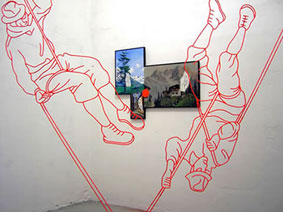
Seilschaft oder Wir kommunizieren nicht mit uns selbst
1992/1993
(20) über "Seilschaft oder Wir kommunizieren
nicht mit uns selbst"
Der philosophische Feldforscher Bourdieu
beschreibt drei systematische Positionen zur Welt als „Habitus“: Die Mittelschicht ist
bildungsbeflissen und setzt auf Leistung, die Oberschicht dagegen verfügt über
ein Gefühl für Distinktion als Unterscheidungsprinzip zu anderen,
und die Unterschicht zeichnet sich durch einen „Notwendigkeitsgeschmack“ aus.
Wer gesellschaftlich aufsteigen will, strebt den nächsthöheren
Habitus an und ist gezwungen, Allianzen einzugehen. In bestimmten Bereichen
der Gesellschaft sind jeweils bestimmte Gruppen maßgebend, die
sich allerdings selbst reproduzieren: die Eliten. Diese verfügen über
eine oder mehrere Formen von Kapital, nämlich kulturelles, ökonomisches
und/oder soziales. Der ökonomische Wert von Beziehungen zeichnet
sich in den Fragestellungen ab: Wen kennt man? Wer kann nützlich
sein? Wie kann soziales in ökonomisches Kapital verwandelt werden?
Wenzel
Mraček: Der Kopf des W.W. Anger
Versuch, mittels Literatur mit dem Künstler zu denken
Seite 119
(21) über "Tatsachenkörper"
Die Abbilder der Körperteile von W.
W. Anger wirken disparat und deuten mit ihren Antennen nur hypothetisch
auf die Möglichkeit hin,
den Gesamtkörper aus eigenen Stücken wiederherstellen zu können.
Es besteht die Gefahr, vergleichbar mit der Puppe Hans Bellmers, in eine
Anagrammatik des Körpers zu verfallen, die hier durch Systematisierung
vermieden wird. Man ist auch an Ernst Machs Beschreibung des multiplen
Ichs erinnert, nach der sich die Persönlichkeit zu keiner Zeit als
absolut begreifen lässt, mehr noch, quasi beliebig manipuliert und
auf allfällige Anforderungen eingestellt werden kann. So aber diese
Körperteile, von außen gesteuert, gleichsam assembliert werden
könnten, wird der Kopf als Steuer- oder Erkenntniszentrale (wie
noch in Egozentrisches Universum) obsolet. Gefordert ist nach Ernst Mach
vielmehr „das völlig charakter- und personlose Individuum,
das sich auf die vielfältigen ideologischen Angebote zu einer jeweils
neuen Person montiert“. Und tatsächlich beinhaltet W. W. Angers
Tatsachenkörper kein Bild seines Kopfes.
Wenzel
Mraček: Der Kopf des W.W. Anger
Versuch, mittels Literatur mit dem Künstler zu denken
Seite 121
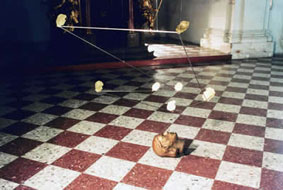
Egozentrisches
Universum
1990/1992
(22) über "Egozentrisches Universum"
Wenn ich mein ganzes privates Universum
so genau wie möglich kartographiere,
so müsste am Schluss ein Selbstporträt entstehen. Das Selbstporträt
ist der blinde Fleck, der den Standpunkt bezeichnet, von dem aus das
Universum gesehen wird. Also eine negative Beschreibung. (...) Der verbleibende
unsichtbare und wohl auch unbekannte Rest, das müsste dann das
Ich sein. Aus nichts anderem bestehend und durch nichts anderes zu definieren
als durch seine Umgebung. Ein NEGATIV.
W.W. Anger
1991-06-03
Seite 131
(23) über "Fuck You - Fuck Me"
Das ganze soll an Hülsen oder verlassene
Kokons erinnern, gleichzeitig ist aber der eindeutig sexuelle Charakter
der ganzen Arbeit unübersehbar.
Was mich an der Sache insbesondere interessiert, ist dieses System des
Verhüllens und Verdeckens, um das Interesse am Verhüllten anzuheizen.
Im Laufe der Zeit ist aber dieser ursprüngliche Antrieb verloren
gegangen und die Hülle selbst wird immer mehr zum Objekt der Begierde,
zum Fetisch. Die ursprünglichen Objekte der Begierde verschwinden
und zurück bleiben die leeren Hülsen oder Fetische.
W.W. Anger, 1993-04-20
Seite 141
(24) über "Still/Leben"
Ausgangspunkt für diese Arbeit ist am ehesten dieses Gefühl,
dass das kapitalistisch expandierende neoliberale Wirtschaftssystem
immer auch neben Glücksversprechungen eine Todesdrohung mit sich
bringt: die Drohung der Macht, die Drohung des Ausschlusses.
W.W.
Anger, 2003-12-29
Seite 143
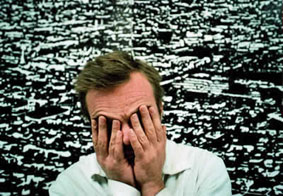
Headquarter
1998
(25) über "Headquarter"
Ein bisschen möchte ich diese Arbeit auch an die Tradition der
Vedutenmalerei eines Canaletto angebunden wissen mit der vollen Absicht,
das anachronistische Moment dieses Unterfangens herauszustreichen ...
Natürlich ist mir auch die Naivität dieses Unternehmens bewusst
und diese künstlerische Naivität ist dann eben auch Bestandteil
des ganzen Themas. Es geht eben darum, etwas darstellen zu wollen, was
sich eben so gar nicht darstellen lässt und gerade an diesem Versagen
doch noch etwas über den ursprünglich anvisierten Gegenstand
der Darstellung zu erfahren!
W.W. Anger, 2003-04-07
Seite 165
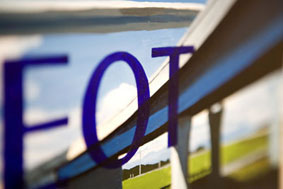
Import - Export -Freizeit
(26) über "Import - Export - Freizeit"
Sind die Landschaften nichts anderes als
Bebilderungen der leeren Planquadrate und damit Nachrichten von unbekannten
Orten, so sind die Reihen der Autos die Leiterbahnen des dazugehörigen Informationssystems. Die
leeren Räume des Unbekannten, (...) so leer, wie nur irgend etwas
leer sein kann, sind sie die idealen Imageträger – Container,
nur dazu da, die Versprechungen der Freiheit in sich aufzunehmen. (...)
Die Bilder beziehen sich aber auch auf die mediale Konstruktion von
Landschaften und Metropolen.
Aus: Bill Grawen, Kein Frühstück
im Grünen
Seite 167
Alle Zitate aus:
Werner Fenz (Herausgeber):
W.W. Anger.subSYSTEME.Das
Werkbuch
|